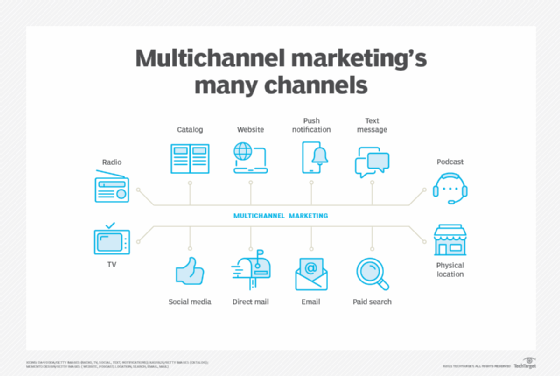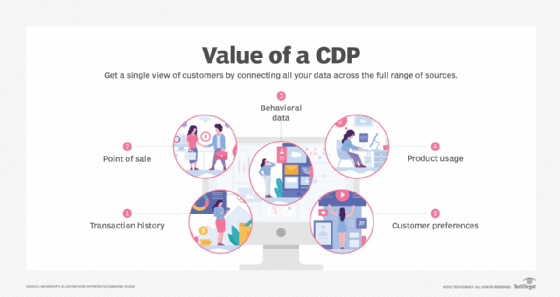What is multichannel marketing?
Multichannel marketing refers to the practice of companies interacting with customers via multiple direct and indirect channels to sell them goods and services. This approach increases the number of options a company can use to reach a target audience and enables customers to complete conversions using their preferred medium.
Companies use direct channels, such as physical stores, catalogs and direct mail, to proactively reach the customer. They use indirect channels, also known as inbound marketing, to push content using websites or social media.
Companies also reach customers with multichannel marketing through mobile devices, text messaging, email, company websites, social media and search engine optimization (SEO). They also use the Global Positioning System (GPS) to track customers' proximity to goods and services. Multichannel marketing combines the practices of inbound and outbound marketing with the goal of reaching customers on the channel of their choice. In this way, the customer controls the buying process more than the marketer.
Multichannel marketing gives customers more ways to get product information. The spread of available channels, including the growth of email, social media and mobile, has resulted in marketing departments increasing their presence on these channels to advance their customer relationship management (CRM) efforts.
The old ways of marketing, such as using print sources, telemarketing and broadcasting on radio and TV, are no longer the sole focus of marketing departments. Although these methods are still used, they're part of a bigger strategy that includes new media. Marketing strategies evolve along with changing customer tastes and communication preferences.

How to build a successful multichannel marketing strategy
Multichannel strategies are long-term plans meant to establish brand awareness and maintain relationships with prospective and existing customers. The following techniques can help organizations ensure a successful customer-facing multichannel strategy:
- Develop analytics. Organizations should use customer data platforms to collect and analyze customer data from several sources. Analytics enables companies to use customer behaviors and demographic information to determine which customers get which marketing messages. Creating a personalized marketing strategy increases the likelihood of customer engagement and a positive customer experience (CX).
- Understand channel preferences. Companies can create detailed buyer persona profiles, enabling them to target the right audience with the right content marketing. Multiple channels can be used per campaign if the same customers are exposed to those channels.
- Cross-channel marketing consistency. Businesses should devise marketing and other campaigns that span multiple channels. Expecting customers to adapt to the company's preferred channel is unrealistic. Companies should also coordinate the online and offline channels they use. For example, keyword testing from online marketing can inform organizations about the effectiveness of certain campaigns before they're made into advertisements. Coordinating in-store experience with digital marketing channels is another approach.
- Measure attribution. Once a multichannel campaign is completed, a company should evaluate its performance. This helps it determine which channels were successful and which had the most influence on outcomes. Businesses can choose from several marketing attribution models to do this. Knowing which campaigns on which channels lead to the most sales helps businesses determine the effectiveness of their efforts and measure the return on investment of their presence on each channel.
- Choose the right platform. The multichannel marketing platforms an organization chooses helps it provide campaign management capabilities, predictive analytics and marketing attribution analysis, using inbound and outbound marketing.

Benefits of multichannel marketing
The benefits of multichannel marketing include the following:
- 360-degree view of the customer. Feedback from customers helps companies understand what customers expect and how to improve product and service offerings. Companies can adjust marketing efforts and identify which channels work best for certain customer segments and how to target the needs of specific groups. Having a 360-degree view of the customer can reveal more marketing opportunities and facilitate a more personalized experience for customers.
- Competitive advantage. A multichannel marketing approach lets companies identify gaps in competitors' strategies and focus on channels that others neglect.
- Better sales management. Multichannel marketing encourages the use of crowdsourced information, which can help companies assess and improve their performance. This approach, coupled with all the other feedback across different customer segments, ensures resources are used efficiently and reduces operational costs.
- Greater visibility and sales. The more visible a message is, the more potential customers a company can attract. Marketing on a single channel reduces customer reach. Companies can use their presence on different channels to build a customer following, reinforce brand and product messaging, and boost retention and customer loyalty.
- Increased engagement. The more channels used, the more potential customers an organization can reach and the more ways they can communicate with them.
Multichannel marketing challenges
There are several challenges inherent in multichannel marketing:
- Inconsistency. Each channel is unique and has its own requirements for marketing. This can make it difficult to manage a consistent message across all channels, departments and brands. Some information might be lost when a particular channel doesn't accommodate in-depth messaging.
- Uncoordinated technology. Channels can have different technology requirements and different assets available to them. This makes it difficult to coordinate technology among channels and get proper IT staff and support for all channels.
- Measurement issues. It can be difficult to measure some aspects of the marketing message across multiple channels, such as brand reach, consistency or engagement levels. It can be hard to isolate which channel or customer touchpoint triggered a response. And one channel might primarily provide qualitative data, which can be harder to interpret if the technology available is geared for quantitative data.
- Insufficient use of marketing analytics. It's difficult for some organizations to add customer data to existing profiles or to maintain data quality in customer profiles.
Channels used in multichannel marketing
The following are examples of channels used in a multichannel campaign:
- Websites. Websites provide powerful tools that optimize SEO data into actionable marketing activities. They're essential for successful multichannel marketing campaigns and typically prompt customer conversions.
- Email. This is an older channel. Marketers can coordinate emails with other channels. For example, they can send a follow-up text message to a customer shortly after they've opened an email marketing message.
- Physical storefronts. Depending on the industry, physical storefronts can play an important role in customer connection and satisfaction. They can also determine the approach other channels must apply to match the customer service at the physical storefront.
- Push notifications. These are often displayed on a webpage or in a mobile app. For example, push notifications are used to offer rewards for purchasing something in a specific time frame.
- Text messages. Companies can send customers text messages that advertise deals or updates on something they previously expressed interest in on another channel.
- Podcasts. Podcasts can extend advertising to an audio format, similar to traditional radio ads.
- Social media. Listening tools that track what people are saying about a brand or product on social media can be used to aggregate customer feedback and integrate it with a CRM platform. Sentiment analysis can also provide insights from customer input on social platforms.
- Physical mail. Companies can give potential customers advertisements, pamphlets and flyers through physical mail.
- Sponsored media and paid ads. Businesses can pay to run advertisements on other websites or on video platforms, such as YouTube, to reach customers. They can pay to sponsor social media influencers.
Multichannel marketing examples
Real-world examples of multichannel marketing provide insight into how businesses can effectively use and coordinate different marketing channels.
Vrbo
This company offers an application that lets users book short-term vacation rentals. Vrbo tailors its website and application experience to work on multiple devices and meet customers where they are. It distributes user-generated content, like pictures and reviews of vacations booked using the app, across social media platforms to appeal to prospective users and raise brand awareness.
Vrbo serves social media users with targeted advertisements. Search query information is carried across platforms, so if someone searches for vacation information on one platform, Vrbo can use insights from that search to serve an ad at another time and platform. This increases brand reach and improves customer retention, reengagement and brand loyalty.
CVS
CVS aims to replicate the in-store pharmacy experience through its web and mobile applications. Customers can check and fill prescriptions, register for health services and handle other shopping needs on the platform. The application has an online chat function that lets customers speak to a pharmacist. Customers can also receive in-app notifications about their prescriptions. By coordinating digital channels with the physical CX strategy, CVS increases brand reach and makes messaging consistent and convenient for customers.
Multichannel marketing vs. omnichannel marketing
Multichannel and omnichannel marketing differ in important ways:
- Multichannel marketing. In multichannel marketing, each channel exists in a silo. Some information is restricted to that channel, and there are boundaries between channels. Having information in silos can result in inconsistencies across channels. Customers might be forced to repeatedly provide or view the same information, leaving them with the impression that the organization has a limited understanding of the customer journey.
- Omnichannel marketing. Omnichannel marketing is an evolution of multichannel marketing. It removes barriers between channels and eliminates information silos. It carries information about the customer -- and for the customer -- between channels so the same information is available on every channel. As a result, there's more consistency across channels in the information provided, branding, and customer or user experience.
Benefits of omnichannel marketing
Omnichannel marketing reduces repetition across channels. The omnichannel environment retains customer behavior across channels and along the customer journey. If a customer uses one channel, they don't have to repeat steps or view redundant information as they switch channels.
With all the channels equally aware of customer behavior, an organization can provide customers with a coordinated, seamless experience. This information sharing also gives organizations a better understanding of how customers behave and their preferences.
The future of multichannel marketing
Despite the development and growth of omnichannel marketing, multichannel marketing has a strong global following among businesses of all sizes and types. The automation of the marketing process is now a commonplace activity that will remain important in the coming years.
Learn about the best practices for customer data collection that satisfy government regulations and fulfill business and customer needs.





